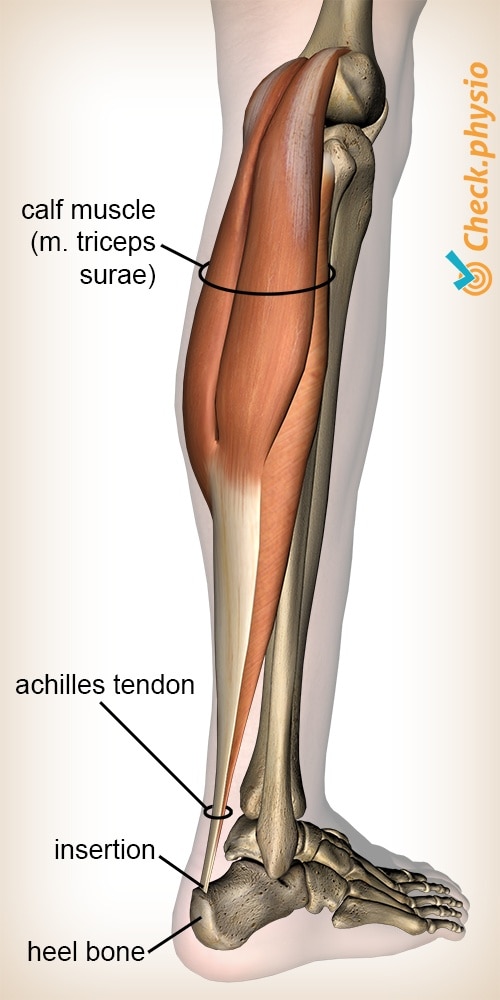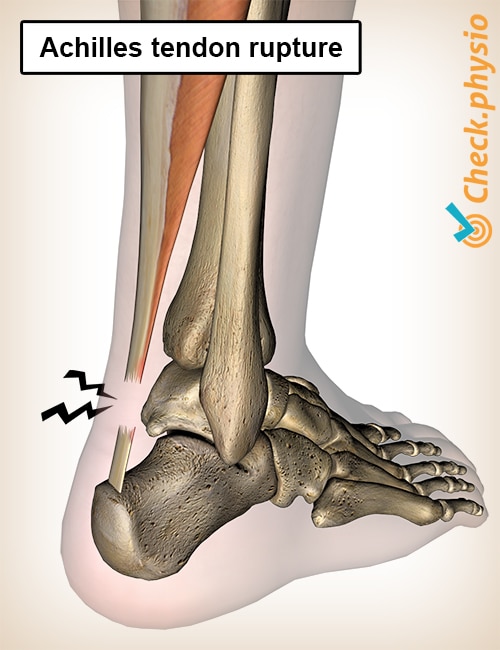Achilles tendon rupture
Torn Achilles tendon
The Achilles tendon is the tendon located at the back of the foot and ankle. It connects the calf muscle to the heel bone. An Achilles tendon rupture is a tear in the Achilles tendon, which has serious consequences for the ankle and foot.

Description of condition
The calf muscles (triceps surae) enable us, via the Achilles tendon, to move our foot downward. This is essential to be able to walk properly.
When the Achilles tendon tears, we call this an Achilles tendon rupture. The tendon can rupture partially or completely. An Achilles tendon rupture can occur in healthy tendon tissue or when the tendon is weakened. Weakened tendons are more common later in life.
Cause and history
If the Achilles tendon tears, it is usually during sports or other strenuous activity. However, the Achilles tendon can also tear while performing relatively light activities. This usually means that the tendon's condition was already poor. This is called degeneration of the tendon tissue.
Most Achilles tendon ruptures occur in athletes between the ages of 30 and 40. The ratio of men to women with an Achilles tendon rupture is 10:1.
The risk of Achilles tendon rupture is, for example, further determined by:
- Use of certain medications (corticosteroids, some antibiotics).
- Presence of a systemic disease (rheumatism, gout, lupus)
- Fatigue.
- Making unexpected movements.
- Lack of physical fitness.
Signs & symptoms
When the Achilles tendon tears completely, moving the foot downward (plantar flexion) is no longer possible. However, it will still be possible with a partial tear, but will be very painful.
The patient's symptoms include:
- Pain in the Achilles tendon area.
- Warmth, redness and swelling around the Achilles tendon.
- Loss of strength in the calf muscle.
- Normal weight-bearing on the leg is no longer possible.
- You may feel and/or see a gap in the tendon.
Diagnosis
If a full tendon tear is suspected, a doctor or physiotherapist can determine this using a squeeze test (the Thompson test). When the calf is squeezed, the foot should move. If this is not the case, the Achilles tendon is probably ruptured completely. In addition, a gap in the tendon can often be felt and/or seen. This will create a dimple or a small dent in the Achilles tendon.
If the Achilles tendon is partially torn, the foot still moves during the squeeze test. An ultrasound can then provide more clarity on the severity of the injury.
Treatment
The severity of the Achilles tendon rupture in combination with other factors such as age, occupation and activity level will determine further treatment.
A completely ruptured Achilles tendon can be treated in two ways: non-surgically (conservative) or surgically. In conservative treatment, the lower leg is put in a cast for 6-8 weeks with the forefoot pointing downward (equinus position). In this position, the tendon extremities are adjacent to each other to grow back together. This equinus position is reduced gradually until the foot is flat again.
In surgical treatment, the surgeon stitches the ends of the torn tendon back together again. After this operation, the tendon needs time to recover. Therefore, even after surgery, a plaster cast will be worn for 6-8 weeks with the foot in the equinus position.
No operation is without risk. There is a risk of thrombosis, subsequent bleeding or wound infection. In a few cases, the Achilles tendon can tear again. Fortunately, these complications are rare.
During the weeks that the leg is in the plaster cast, it is important to elevate it regularly to avoid swelling of the ankle and foot. You should walk with crutches to take weight off the leg.
After the plaster cast has been removed, the ankle will feel stiff and it will be more difficult to lift the foot (dorsiflexion). The ankle or Achilles tendon region may still be a little swollen. The calf muscle will have decreased in size, strength and endurance, and the Achilles tendon itself will still be weak as well. It is therefore important to start exercising as soon as possible in order to regain strength again. This can be done under the supervision of a physiotherapist.
The total recovery time for an Achilles tendon rupture is about 3-6 months, depending on the demands that the tendon is subjected to. A top athlete will generally need to rehabilitate longer than someone who only needs to be able to walk.
Exercises
You can check your symptoms using the online physiotherapy check or make an appointment with a physiotherapy practice in your locality.

References
Brukner, P. & Khan, K. (2010). Clinical sports medicine. McGraw-Hill: Australia. 3e druk.
Nugteren, K. van & Winkel, D. (2009). Onderzoek en behandeling van de voet. Houten: Bohn Stafleu van Loghum.
Verhaar, J.A.N. & Linden, A.J. van der (2005). Orthopedie. Houten: Bohn Stafleu van Loghum.



